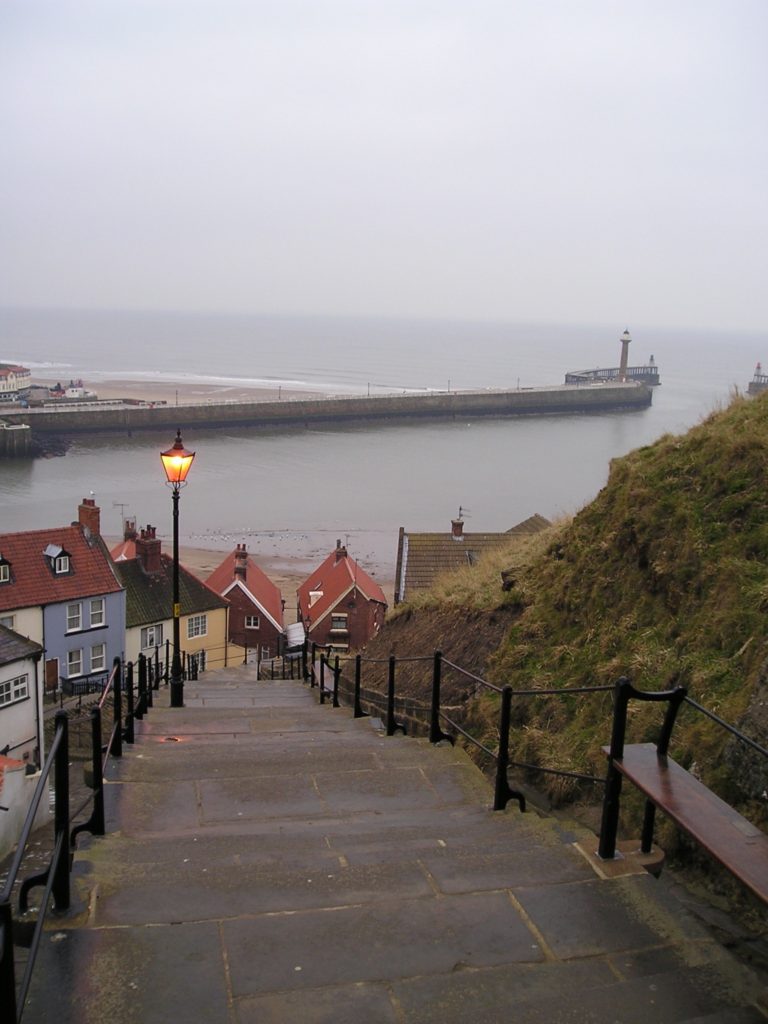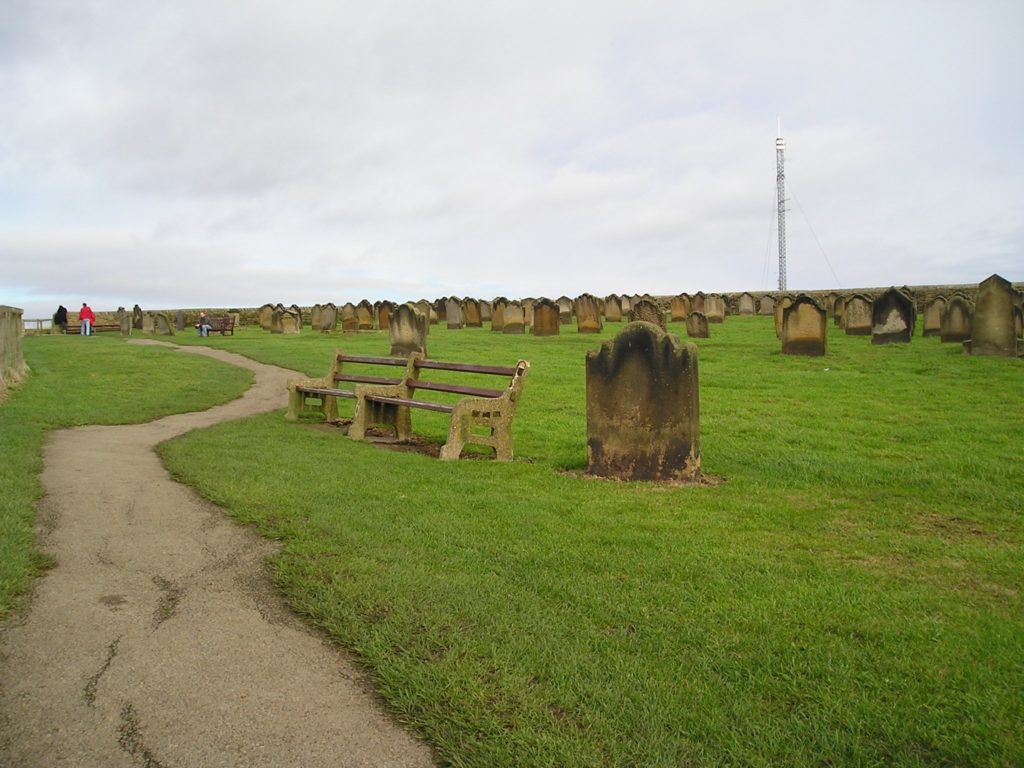Here we are. We’ve reached the end of guest blogger Psychic Investigator Paul Fitz-George’s series, “Whitby’s Fascination for the Literati or how Dracula met the Jabberwocky.”
It’s been a whirlwind tour. Part 1 led us through Whitby’s haunted history. Parts 2 through 5 told of Whitby’s influence on Bram Stoker, Wilkie Collins, Lewis Carroll, and Charles Dickens.
In this final post, Mr. Fitz-George discusses Whitby’s phenomenon that plays a part in Stoker’s book, specifically Wafts, the Boh-Ghost, and the 199 steps.
Stoker’s corpse-manned ship is based on a real event, which he probably found out about by either looking in the subscription library’s records, or from one of the garrulous old whalers and fishermen of the town. Many of these old salts would have been seen trawling along Whitby’s piers during Stoker’s stay and their appearance and characters no doubt formed the basis of some of the characters in his story.
Interestingly, there were still many old seamen in the town akin to these, when I worked there in the 1980’s as The Collector of Dues for the harbour and I, like Stoker, used some of their tales for my own book on the Spirit World.
Those he came across would have helped him conceive and put together individuals within Dracula such as the likeable and yarn-spinning Mr Swales or ‘Sir Oracle’ (as Mina calls him), who befriends Mina and the doomed Lucy. These old locals’ knowledge of the town’s folklore, would have been invaluable to Stoker for filling in details about its supernatural goings-on, such as the ‘wafts’ and ‘boh-ghosts’ that Mr Swales mentions. These phenomena are in fact based on well known local legends that I used to scare the wits out of tourists with, when I narrated them during my evening ‘Whitby Ghost Walk’ during the nineteen eighties.
The Waft for example, is a supernatural entity mentioned in Robinson’s ‘A Glossary of Yorkshire Words and Phrases Collected in the Whitby Neighbourhood’ that was published in 1855, pages 187-188, the extract for it reading as follows: –
‘A WAFT, a gliding spectre. ” I saw his waft,” the semblance of the living person, of whose death the supposed appearance of the waft is said to be a denotation !’
Make no mistake, the waft apparitions that duplicated you in every detail, were soul-stealing killers. If you saw one of them in a shop or in the street, there was only one way of fending it off before it stole your soul and destroyed you. You immediately had to issue a challenge (preferably in the local vernacular) on the lines of, ‘What’s thou doing here?’ ‘Thou’s after no good I’ll go bail, get thy ways yom wit thee, get thy ways yom! In doing this you were saved (hopefully), the waft skulking away to find weaker and easier prey.
The waft is also known by another name to the more academically orientated and that is the doppelganger or ‘double-goer’. This word is German in origin, Whitby having had close trading connections with northern Germany right up to the 19th century. The German version has a similar portent of trouble attached to it, though thankfully not as severe as the Whitby version, this being that it is a harbinger of bad luck or perhaps indicating the existence of an evil twin.
The ‘boh-ghost’ that Mr Swales mentions is also a well-known apparition in Whitby and throughout Yorkshire. In Whitby it’s commonly known as ‘The Barguest’, a huge black hellhound with glowing eyes that stalks Whitby’s night-time streets.
It is said that if you hear the ‘howl of the Barguest’, you are not long for this life…gulp! Sound familiar? Of course it does, it’s the ‘immense dog’ in Stoker’s novel that ‘sprang up on the deck from below…and running forward, jumped from the bow (of the stricken Demeter) on to the sand’.
It’s Dracula, making his escape from the beach at Collier’s Hope and haring off up the 199 steps to the suicide’s grave on unhallowed ground in the churchyard above. Which quite nicely brings me to the grave that Dracula inhabits and over which the unfortunate girls favourite bench lies.

Going up the torturous 199 steps to the church at Whitby, is thigh-stretching agony and it’s almost as bad if you take the nearby ‘donkey road’ directly to the side of it.
As you follow the route that Dracula in his form as a hound scampered up, you come across several benches that have an interesting history and usage. They are seats yes, but also ‘coffin rests’ that were placed there so that the tired pallbearers taking coffins up to the church could take a well-earned rest. Their grateful use thus ensuring that the pallbearers did not join the departed that they were carrying in the coffin, when they finally reached the church at the top.
Once in the churchyard, we have a glorious view over the bay from the cliff-side’s benches and we can also glance at the stories on the row upon row of tombstones celebrating Whitby’s honoured dead. The departed here range from ordinary folk to ship’s captains murdered by pirates in far-flung lands and Stoker would most certainly have come up here, to see and possibly add details from the tombstones’ narratives to his great tale.

Got an idea you’d like to submit? We’re always looking for quality infotaining posts about true crime, horror, and the paranormal –or some blend thereof. Visit our Writers Wanted page for submission details. We’d love to have you join our Skeleton Crew!
P.S.
Yes.
That’s the answer to that question we know you’re wondering about. We do pay. Not a lot. Don’t get excited. But we believe in paying writers for their time and energy. You’ll find complete details on the Writers Wanted page.

